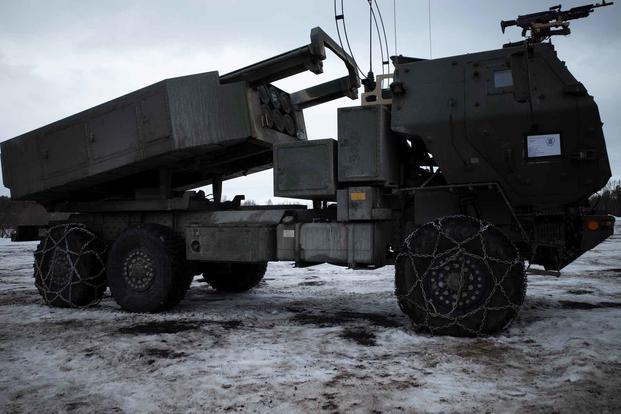Drew F. Lawrence

For more than two decades, the High Mobility Artillery Rocket System, or HIMARS, has served as a key piece for U.S. deterrence, including in Europe. The launchers, built on the back of trucks and designed to send missiles or rockets over 150 miles to hit targets the size of a trash can using GPS, have also recently seen ample action in Ukraine as forces have worked to repel the Russian invasion.
But the Marine Corps plans to retire its HIMARS over the next several years, instead prioritizing other platforms to pick up the capability a mobile rocket or missile launcher would offer, and heading full-tilt toward its coastal mission.
At the moment, however, they're still a key part of the U.S. arsenal as put on display during the Nordic Response '24 NATO exercise that included Marines earlier this month in Alta, Norway.
"If Putin decides to get ballsy and go off and do worse things than he's doing right now," one sergeant, a HIMARS maintainer, told Military.com during the exercise, "I'm going to be back out here fixing these things for us and for other countries, helping them out."
The system has been a boon on the battlefield for Ukraine. The U.S. sent 39 of the rocket/missile launchers to the country, and according to media reports, Russia hasn't destroyed a single one as of earlier this year -- a testament to the mobility of the system.
"They're all the hotness in the news right now," 1st Lt. Morgan Long, the platoon commander for the HIMARS detachment in Norway, told Military.com. "What's great about them is their mobility, and then their distance that they can shoot. You've got a system that can shoot further than the enemy can run away. And then it's a system that can run away faster than the enemy can shoot 'em."
Long said he was learning from these global events and applying those lessons learned from other militaries, adding that "we can create a product ... that's been battle-tested, maybe by us, maybe by someone else."
Yet, in accordance with the service's modernization plan, which -- in part -- wraps missile capabilities around its littoral units, the Corps is now looking at the Multiple Launch Rocket System, or MLRS. With a similarly advertised range to HIMARS, depending on the munition, the MLRS is tracked instead of wheeled, heavier and has been battle-tested since the 1980s. The Corps has had HIMARS since the early 2000s.
The service will also use the Navy/Marine Corps Expeditionary Ship Interdiction System, or NMESIS, which it procured last year. That system is mounted on a Joint Light Tactical Vehicle, is designed specifically for killing ships from land and has a shorter range of about 60 less miles than the HIMARS.
The Marines in Norway told Military.com that HIMARS can also hit ships from land, but the NMESIS employs the Naval Strike Missile, which is specifically designed for over-the-horizon ship-destroying and fits nicely into the service's littoral aspirations.
"The priority is the anti-ship missile, and the HIMARS in the active component must be divested," Maj. Eric Flanagan, a spokesperson for the Corps modernization efforts, told Military.com on Monday. He said there is not a specific date associated with retiring the system, and that it is dependent on fielding other units, acquisition of systems and any supply chain issues that may pop up.
Marine Corps Times first reported that 5th Battalion, 11th Marines -- a rocket and missile unit -- will deactivate this month. The modernization effort has also changed Marine artillery overall, with the deactivation of 1st Battalion, 12th Marines last year, an artillery unit that tested the NMESIS system early in the Corps' adoption of it.
Now, the active-duty component of the Marine Corps will have two battalions with HIMARS. The reserves will have one battalion, according to Flanagan. While the retirement of the system is bittersweet to the Marines on the ground, its importance was still recognized.
"The location of the HIMARS system itself is not the important part; it's the ability to maneuver and position at a time and place of our choosing," Flanagan said.
No comments:
Post a Comment